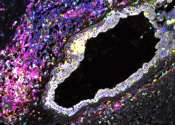Ovarian cancer is a cancerous growth arising from different parts of the ovary.
The most common form of ovarian cancer (≥80%) arises from the outer lining (epithelium) of the ovary. Other forms arise from the egg cells (germ cell tumor).
In 2004, 25,580 new cases were diagnosed and 16,090 women died of ovarian cancer. The risk increases with age and decreases with pregnancy. Lifetime risk is about 1.6%, but women with affected first-degree relatives have a 5% risk. Women with a mutated BRCA1 or BRCA2 gene have a 25% risk. Ovarian cancer is the fifth leading cause of death from cancer in women and the leading cause of death from gynecological cancer.
10-year relative survival ranges from 84.1% in stage IA to 10.4% in stage IIIC.
Ovarian cancer causes non-specific symptoms, which contribute to diagnostic delay, resulting in a late stage and a poor prognosis. Most women with ovarian cancer report one or more symptoms such as abdominal pain or discomfort, an abdominal mass, bloating, back pain, urinary urgency, constipation, tiredness and a range of other non-specific symptoms, as well as more specific symptoms such as pelvic pain, abnormal vaginal bleeding or involuntary weight loss. There can be a build-up of fluid in the abdominal cavity (this is called ascites).
An abnormal physical examination (including a pelvic examination), a blood test (for CA-125, more specifically) or medical imaging studies can provide evidence leading to an ovarian cancer diagnosis. The diagnosis can be confirmed with a surgical procedure (open or keyhole surgery) to inspect the abdominal cavity, take biopsies (tissue samples for microscopic analysis) and look for cancer cells in the abdominal fluid. Treatment usually involves chemotherapy and surgery, and sometimes radiotherapy.
In most cases, the cause of ovarian cancer remains unknown. Older women, and in those who have a first or second degree relative with the disease, have an increased risk. Hereditary forms of ovarian cancer can be caused by mutations in specific genes (most notably BRCA1 and BRCA2, but also in genes for hereditary nonpolyposis colorectal cancer). Infertile women and those with a condition called endometriosis, those who have never been pregnant and those who use postmenopausal estrogen replacement therapy are at increased risk. Use of oral contraceptive pills is a protective factor. The risk is also lower in women who have had their uterine tubes blocked surgically (tubal ligation).









